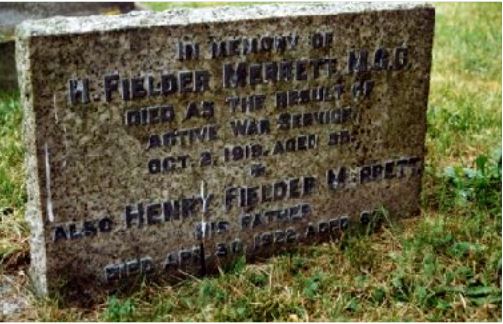10th Battalion, Machine Gun Corps (Infantry)

Henry Fielder Merrett was born at Standish, Gloucestershire in early 1886, the son of Henry Fielder Merrett, a farmer, and his wife Constance Kate. The couple had five children, two sons and three daughters.
He appears to have followed his father into agricultural work and after being employed in Gloucestershire he became a hunt servant, probably working for one of the large estates in Scotland.
He enlisted, for the duration of the war, at Dunkeld on 16 November 1915 and joined the Territorial Army unit, 3/1st Scottish Horse Yeomanry (number 5021), giving his home address as Lystonville, Bishop’s Cleeve.
On 1 February 1916 he was appointed as a Lance Corporal and on 5 September 1916 he transferred to 29 Company, Machine Gun Corps (MGC) (Infantry). On 16 September 1916 he sailed with his unit from Devonport to Salonika, arriving there on 30 September. He was to serve at the Salonika front until 18 September 1917, after which he sailed for Alexandria, Egypt, arriving 25 September. He remained in Egypt from 26 September and 3 August 1919. During this time 29 Company, MGC fought in the battles of Gaza, Nablus and the capture of Jerusalem.
During this time, on 19 October 1917, he was admitted to a casualty clearing station suffering with malaria and was admitted to 31 General Hospital, Port Said on 26 October. A further transfer was made on 4 November 1917, to 70 General Hospital, Cairo and the lingering malaria caused him to be downgraded to ‘B1’ on 29 January 1918. On 7 May 1918, 29 Company, MGC became 10th Battalion, MGC.
The malaria appears to have taken a hold, as Lance Corporal Merrett’s Army Service Record notes a further admission to 70 General Hospital, Cairo on 27 April 1918. Treatment appears to have continued before he was finally sent back to the UK on 4 August 1919, arriving on the 19th. On arrival he was further downgraded to ‘B2’ and was disembodied on 17 September 1919, having served for over three and a half years.
On 3 October 1919 Fielder Merrett died at the family home at Lystonville, Bishop’s Cleeve, a result of malaria and pneumonia. He was 33 years of age and unmarried. Notice of his death appeared in the Gloucestershire Echo of 4 October and on 7 October he was buried in the churchyard of St Michael’s, Bishop’s Cleeve, where a private headstone was place on his grave, which also records the death of his father in 1922.
Researched by Graham Adams 23 May 2016
(Acknowledgment to Graham Sacker, for information supplied)
